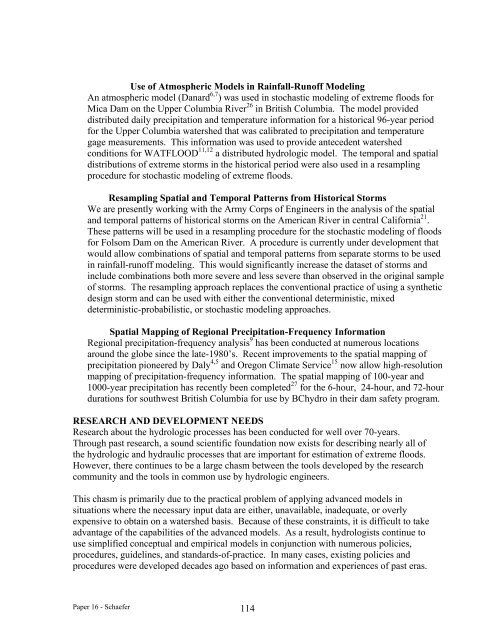Hydrologic Issues for Dams - Association of State Dam Safety Officials
Hydrologic Issues for Dams - Association of State Dam Safety Officials
Hydrologic Issues for Dams - Association of State Dam Safety Officials
Create successful ePaper yourself
Turn your PDF publications into a flip-book with our unique Google optimized e-Paper software.
Use <strong>of</strong> Atmospheric Models in Rainfall-Run<strong>of</strong>f ModelingAn atmospheric model (Danard 6,7 ) was used in stochastic modeling <strong>of</strong> extreme floods <strong>for</strong>Mica <strong>Dam</strong> on the Upper Columbia River 26 in British Columbia. The model provideddistributed daily precipitation and temperature in<strong>for</strong>mation <strong>for</strong> a historical 96-year period<strong>for</strong> the Upper Columbia watershed that was calibrated to precipitation and temperaturegage measurements. This in<strong>for</strong>mation was used to provide antecedent watershedconditions <strong>for</strong> WATFLOOD 11,12 a distributed hydrologic model. The temporal and spatialdistributions <strong>of</strong> extreme storms in the historical period were also used in a resamplingprocedure <strong>for</strong> stochastic modeling <strong>of</strong> extreme floods.Resampling Spatial and Temporal Patterns from Historical StormsWe are presently working with the Army Corps <strong>of</strong> Engineers in the analysis <strong>of</strong> the spatialand temporal patterns <strong>of</strong> historical storms on the American River in central Cali<strong>for</strong>nia 21 .These patterns will be used in a resampling procedure <strong>for</strong> the stochastic modeling <strong>of</strong> floods<strong>for</strong> Folsom <strong>Dam</strong> on the Amer ican River. A procedure is currently under development thatwould allow combinations <strong>of</strong> spatial and temporal patterns from separate storms to be usedin rainfall-run<strong>of</strong>f modeling. This would significantly increase the dataset <strong>of</strong> storms andinclude combinations both more severe and less severe than observed in the original sample<strong>of</strong> storms. The resampling approach replaces the conventional practice <strong>of</strong> using a syntheticdesign storm and can be used with either the conventional deterministic, mixeddeterministic-probabilistic, or stochastic modeling approaches.Spatial Mapping <strong>of</strong> Regional Precipitation-Frequency In<strong>for</strong>mationRegional precipitation-frequency analysis 9 has been conducted at numerous locationsaround the globe since the late-1980’s. Recent improvements to the spatial mapping <strong>of</strong>precipitation pioneered by Daly 4,5 and Oregon Climate Service 15 now allow high-resolutionmapping <strong>of</strong> precipitation-frequency in<strong>for</strong>mation. The spatial mapping <strong>of</strong> 100-year and1000-year precipitation has recently been completed 27 <strong>for</strong> the 6-hour, 24-hour, and 72-hourdurations <strong>for</strong> southwest British Columbia <strong>for</strong> use by BChydro in their dam safety program.RESEARCH AND DEVELOPMENT NEEDSResearch about the hydrologic processes has been conducted <strong>for</strong> well over 70-years.Through past research, a sound scientific foundation now exists <strong>for</strong> describing nearly all <strong>of</strong>the hydrologic and hydraulic processes that are important <strong>for</strong> estimation <strong>of</strong> extreme floods.However, there continues to be a large chasm between the tools developed by the researchcommunity and the tools in common use by hydrologic engineers.This chasm is primarily due to the practical problem <strong>of</strong> applying advanced models insituations where the necessary input data are either, unavailable, inadequate, or overlyexpensive to obtain on a watershed basis. Because <strong>of</strong> these constraints, it is difficult to takeadvantage <strong>of</strong> the capabilities <strong>of</strong> the advanced models. As a result, hydrologists continue touse simplified conceptual and empirical models in conjunction with numerous policies,procedures, guidelines, and standards-<strong>of</strong>-practice. In many cases, existing policies andprocedures were developed decades ago based on in<strong>for</strong>mation and experiences <strong>of</strong> past eras.Paper 16 - Schaefer 114

















